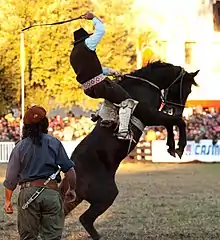.jpg.webp)

Jineteada gaucha or doma gaucha is a traditional sport in the gaucho culture of Argentina and the Cono Sur[1]: 255 – Paraguay, Uruguay, Chile and the Rio Grande do Sul of Brazil. The objective is for the rider to stay on an untamed horse for a number of seconds.[1]: 255 The specified time varies from 8 to 14 seconds, depending on the category.[2] In Uruguay a law was enacted in 2006 establishing it as the National sport.[3] In Argentina it may be considered a part of the national intangible cultural heritage.[1]: 255 [4]: 49
The event forms part of the programme of the annual Festival Nacional de Doma y Folklore held at Jesús María in the province of Córdoba. Under the rules of the competition there, there are three categories:
- Crina Limpia or bareback: the rider holds on to a leather strap passed round the neck of the horse and must stay mounted for 8 seconds; spurs are used[2]
- Sureña or Surera: the horse carries a girthed pad of sheepskin in the place of a saddle; the rider holds the reins in one hand, a whip in the other and must stay mounted for 12 seconds.[2]
- Bastos con Encimera: the horse is saddled; the rider must not lose the stirrups and must stay mounted for 14 seconds.[2]
The rider may not touch the horse with his/her hands at any time.[2]
See also
References
- 1 2 3 Mercedes Mariano, María Luz Endere, Carolina I. Mariano (2014). Herramientas metodológicas para la gestión del patrimonio intangible. El caso del municipio de Olavarría, Buenos Aires, Argentina = Methodological Tools for the Management of Intangible Heritage. The Case of the Municipality of Olavarría, Buenos Aires, Argentina. Revista Colombiana de Antropología 50 (2): 243–269.
- 1 2 3 4 5 [s.n.] (2015). La Jineteada (in Spanish). Córdoba, Argentina: Festival Nacional de Doma y Folklore. Archived 8 March 2016.
- ↑ "Uruguay Law 17958 of 21 April 2006". Global Legal Information Network. Archived from the original on 21 June 2010. Retrieved 14 July 2008.
- ↑ José Alfonso de Guardia de Ponté (2019). El patrimonio cultural folklórico su clasificación (in Spanish). X Encuentro Nacional de Folklore, 14ª Encuentro Nacional de Música, Poesía y Danza y VII Congreso Internacional del Patrimonio Cultural Inmaterial – Salta 2019, pages 36–54.